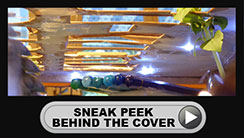
By Claire Doole, Claire Doole Communications
As the adage goes, you don't get a second chance to make a first impression. But never has it been so true in these days of highly competitive job interviews where employers’ pre-screen candidates with a video interview.
According to the Institute of student employers, some 49% of interviewees are asked to do either a live face-to-face interview via video or one that is pre-recorded. In the latter, each candidate is given the same set of questions and timeframe to respond.
All video interviews whether for a job, a corporate video or for the TV can be nerve-wracking but the one-way video interview is particularly challenging, as you don't get any verbal or visual feedback.
Recently, a young woman came to me asking for advice on how to make a good first impression in a one-way video interview for a job she was applying for at an international organisation here in Geneva.
Here are some of the tips I gave her:
1. Dress the set - Remove all those weird art works, embarrassing photos and scruffy books. Make sure there is nothing in vision that can distract from the important points you are making.
2. Dress to impress - The visual channel always takes priority over the verbal and vocal channels so counter this by being sober with your dress. Dress smart as if for a face-to-face interview, but remember the camera doesn't react well to contrasting colours like black and white or to busy patterns such as swirls and checks. Avoid these in favour of block colours. Navy is a safe bet.
3. Apply make-up - This evens out skin blemishes and even men should wear some powder so they don't look shiny or, heaven forbid, sweaty.
4. Eyes are the windows to the soul - Set up the camera so that you are looking straight into the lens. If you look downwards, you will look patronising, whereas if you look up, you will look submissive. Lock in your eye line so it doesn't shift. If you keep glancing away you will appear evasive and untrustworthy. If you need to reflect on an answer quickly look down before looking up again directly at the camera.
5. Think about your posture - Perch slightly forward with your behind well back in the chair (think BBC!) .You want to look interested and alert. Place your feet firmly on the ground, as this will anchor you. It is also a better posture for diaphragmatic breathing than if you cross your legs.
6. The power of your gestures - Use your hands and arms to reinforce the points you want to make. This will also energise your vocal delivery.
7. Get a head start - Make sure your head is balanced evenly on your shoulders - and not tilted to the side as this will make you appear quizzical and uncertain. Don't jut out your jaw, as this will affect the quality of your vocal delivery.
8. Modulate your voice - Speak with impact by adjusting your tone to the message, pausing before and after a key message and keep a smile in your voice to add warmth.
9. Smile and the world smiles with you - You want to show that you are happy to be interviewed so embrace the opportunity to answer the questions with a smile.
10. Amplify your enthusiasm - Video tends to suck the life out of people so you need to compensate by giving more energy than you would to your answers.
If you follow these tips you will be "ready for your close-up" whether you are doing a job interview via video link or giving an interview for your organisation's YouTube channel or to the media.
And one final thought - don't make the mistake of the expert who was giving a serious interview on the BBC about the tensions on the Korean peninsula but was interrupted by his children. He forgot to put a do not disturb sign on his living room door, and went viral for all the wrong reasons!
Author's bio
 Claire is a former BBC correspondent and international spokeswoman who is passionate about helping people communicate with confidence. Since 2006, she has successfully trained hundreds of professionals in the art of presenting and public speaking, talking to the media, managing communications in a crisis, and writing for the web. In addition, she has coached C-level executives and public figures to give powerful TEDx and TED style talks in Europe and the Middle East. A Swiss and UK national, Claire trains and coaches in French and English.
Claire is a former BBC correspondent and international spokeswoman who is passionate about helping people communicate with confidence. Since 2006, she has successfully trained hundreds of professionals in the art of presenting and public speaking, talking to the media, managing communications in a crisis, and writing for the web. In addition, she has coached C-level executives and public figures to give powerful TEDx and TED style talks in Europe and the Middle East. A Swiss and UK national, Claire trains and coaches in French and English.
Claire is also a highly experienced moderator having facilitated panel discussions with government ministers, NGO activists, humanitarians and human rights specialists at major events.









